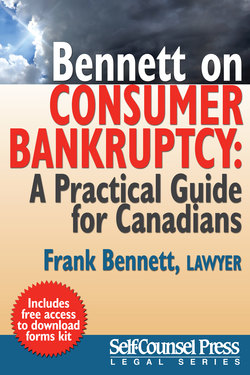Читать книгу Bennett on Consumer Bankruptcy - Frank Bennett - Страница 14
На сайте Литреса книга снята с продажи.
6. Costs
ОглавлениеIn 2000, there were 75,137 consumer bankruptcies in Canada and 12,392 consumer proposals. In 2010, there were a total 135,008 consumer bankruptcies in Canada of which 42,314 made proposals. In 2011, there were a total of 122,999 consumer bankruptcies of which 45,006 made proposals. In most of these consumer bankruptcies, the trustee’s fees ran about $1,800 and up. Under the Bankruptcy and Insolvency Act, there is a prescribed tariff for trustees in performing services for little- or no-asset bankruptcy estates. If the consumer debtor needs a lawyer, the costs will usually be based on an hourly rate. A consumer debtor should be able to get good competent legal advice on bankruptcy matters for less than $1,500. Of course, if there are special problems, the costs are likely to be higher. Therefore, most consumer debtors should have or be able to raise about $3,300 if they want to use the services of a lawyer and a trustee to go bankrupt.
If the consumer debtor has any doubts about bankruptcy or its effects, it is advisable to see a lawyer first before filing as once the consumer debtor files for bankruptcy, it is virtually impossible to annul or reverse its effect.
If the consumer debtor does not have any assets to pay the trustee or a lawyer, then it is possible that the trustee may obtain a guarantee or a cash retainer from a family member or from a friend of the consumer debtor. The guarantee operates only if the trustee is unable to recover property or realize any monies from the property that the bankrupt earns after bankruptcy up to the time of discharge. The guarantee should be in writing and the guarantor, the family member or friend, should read the guarantee very carefully so that it is understood at what is being signed. Trustees usually require that their money be paid before formal proceedings take place.
It is also possible for the consumer debtor to access the Bankruptcy Assistance Program supervised by the Office of the Superintendent of Bankruptcy if the consumer does not have a family member or friend to assist. However, the consumer must first make attempts to retain the services of two private licensed trustees, not be involved in any commercial businesses, and not have any surplus income. If the consumer debtor qualifies, the consumer debtor can contact the local office of the Superintendent where a bankruptcy analyst will designate a participating trustee to administer the bankruptcy or proposal.
